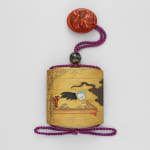A Four-Case Lacquer Inro, Edo Period (19th century)
Rosei sleeps on a low bed in the shade of a tree, a fan held in front of his face. The black mist emanating from him drifts off to the right, covering the reverse of the inro and contains his dream - a court procession.
8 cm. (3 1/8 in.) high (the inro)
3.7 cm. (1 1/2 in.) wide (the netsuke)
3.7 cm. (1 1/2 in.) wide (the netsuke)
Sold
Finely decorated in gold, silver, black and red hiramaki-e, takamaki-e, togidashi, keuchi, kirikane and kinpun against a gold ground. The fan of inlaid mother-of-pearl. The interiors and risers are nashiji...
Finely decorated in gold, silver, black and red hiramaki-e, takamaki-e, togidashi, keuchi, kirikane and kinpun against a gold ground. The fan of inlaid mother-of-pearl. The interiors and risers are nashiji and the rims fundame. Together with an attached carved red lacquer netsuke is of two karashishi playing with a ball and a Somada-style black lacquer ojime with auspicious motifs.
The scene here is based on an 8th Century Chinese moral tale where a man called Lu Sheng (Japanese: Rosei) leaves his village in search of an illustrious career in the civil service. The tale was later adapted in Japan, inspiring the 15th Century Japanese Noh play Kantan, and was modified to reflect the Buddhist philosophy of Noh theatre’s elite warrior audience.
In the Noh drama, Rosei falls asleep and dreams that he is visited by a grand entourage that invites him to become the emperor. When he awakes, Rosei realises that his reign as emperor was simply a vain dream, and in doing so he learns the vanity of human ambition.
On the reverse, Rosei’s dream is depicted as a ghostly procession of servants leading a carriage and horses that would carry him in his dream to the Imperial court to become emperor. The scene is only just visible when the object is turned in the light.
Another inro depicting Rosei's dream is in the collection of the Victoria and Albert Museum, London, accession no. W.247:1-1922, go to:
https://collections.vam.ac.uk/item/O457881/inro/
The scene here is based on an 8th Century Chinese moral tale where a man called Lu Sheng (Japanese: Rosei) leaves his village in search of an illustrious career in the civil service. The tale was later adapted in Japan, inspiring the 15th Century Japanese Noh play Kantan, and was modified to reflect the Buddhist philosophy of Noh theatre’s elite warrior audience.
In the Noh drama, Rosei falls asleep and dreams that he is visited by a grand entourage that invites him to become the emperor. When he awakes, Rosei realises that his reign as emperor was simply a vain dream, and in doing so he learns the vanity of human ambition.
On the reverse, Rosei’s dream is depicted as a ghostly procession of servants leading a carriage and horses that would carry him in his dream to the Imperial court to become emperor. The scene is only just visible when the object is turned in the light.
Another inro depicting Rosei's dream is in the collection of the Victoria and Albert Museum, London, accession no. W.247:1-1922, go to:
https://collections.vam.ac.uk/item/O457881/inro/
Provenance
The Ankarcrona Collection.
Sten Ankarcrona (1861-1936) started collecting Japanese works of art as a young officer in the Swedish navy. On his first visit to Japan in the late 1880s he was captivated by the intricacies of Japanese lacquer and continued to add to his collection after his return to Europe. In 1923, by then an admiral, he went back to Japan at the request of the King of Sweden, at which time he made numerous more purchases. The collection was then further added to by the admiral's descendants throughout the 20th and early 21st centuries.




